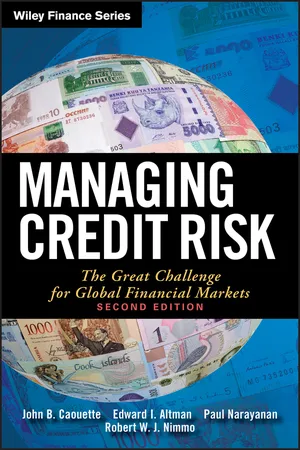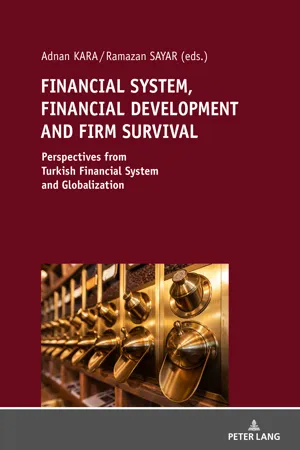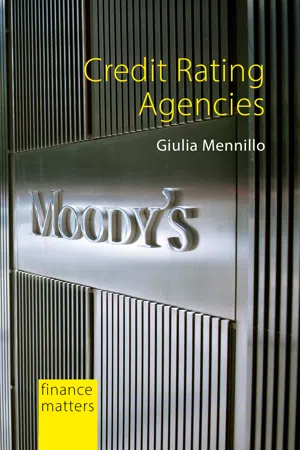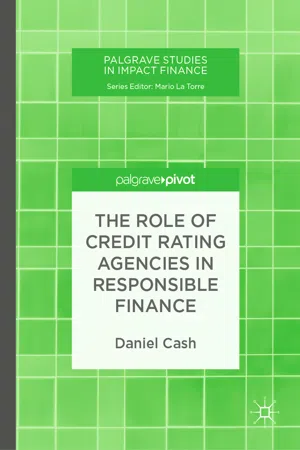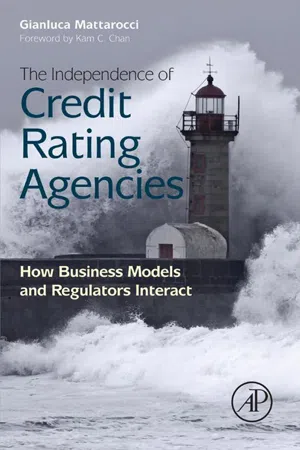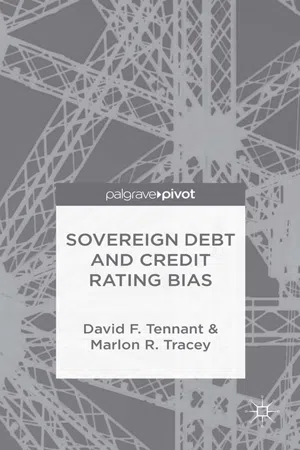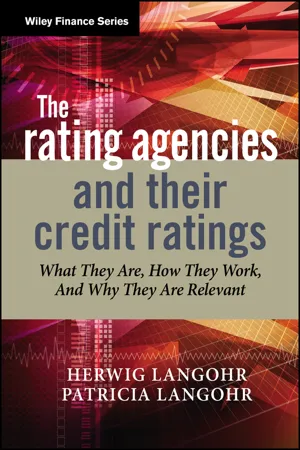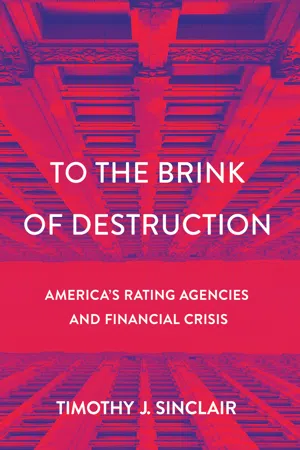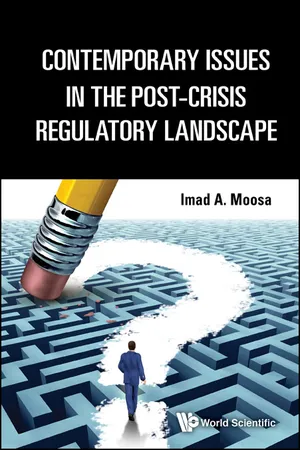Economics
Credit Rating Agencies
Credit rating agencies are firms that assess the creditworthiness of individuals, companies, and governments. They assign credit ratings based on the borrower's ability to repay debt. These ratings help investors and lenders evaluate the risk associated with providing funds, and they also influence interest rates and investment decisions.
Written by Perlego with AI-assistance
Related key terms
1 of 5
12 Key excerpts on "Credit Rating Agencies"
- eBook - ePub
Managing Credit Risk
The Great Challenge for Global Financial Markets
- John B. Caouette, Paul Narayanan, Robert Nimmo, Edward I. Altman(Authors)
- 2011(Publication Date)
- Wiley(Publisher)
CHAPTER 6 The Rating Agencies All that glitters is not Gold; Often have you heard that told.—William Shakespeare, The Merchant of Venice (II, vii)Rating agencies specialize in evaluating the creditworthiness of debt securities issued by corporate, financial, structured finance, municipal, and sovereign obligors, and by evaluating the general creditworthiness of the issuers themselves. It is the job of the agencies to inform investors about the likelihood that they will receive all the principal and interest payments as scheduled for a given security. In other words, what is the probability of repayment?The agencies are tremendously influential around the world today, covering in excess of $34 trillion in securities around the world, and in excess of $750 billion in loans and their businesses are growing at double digit rates (Moody’s Investors Service 2007). Jochen Sanio, president of Germany’s financial regulator BaFin, said the rating agencies do a good job but they nevertheless have become “uncontrolled world powers” (Klein 2004).In some markets—the United States for example—the capital markets have replaced banks as the primary source of debt capital; and ratings agencies have assumed enormous importance in the management of credit risk. The agencies make no recommendations about buying, selling, or holding a particular security or about suitability for a particular investor. Their ratings express nothing more than informed opinions about creditworthiness; although the agencies stress that the opinions are independent, objective, and produced through a transparent and high-quality analytic process. However, these ratings have achieved very widespread acceptance with investors who have confidence in their accuracy and like their convenience and low cost. - eBook - PDF
FINANCIAL SYSTEM, FINANCIAL DEVELOPMENT AND FIRM SURVIVAL:
PERSPECTIVES FROM TURKISH FINANCIAL SYSTEM AND GLOBALIZATION
- Adnan Kara, Ramazan SAYAR(Authors)
- 2020(Publication Date)
- Peter Lang Group(Publisher)
While developing countries finance their development, they need international funds due to insufficiencies in their own resources. Accurate determination of the credibility of borrowing institutions is of great importance in the international markets in which coun- tries, public institutions, private sector organizations, financial institutions, and investors come together. Therefore, credit ratings have become a more widely used indicator in regulation and risk management process (Gür & Öztürk, 2011: 71). The fact that credit ratings contain explanatory information about country risk undoubtedly affects the economies of the country to a great extent. The effects of ratings on the country's economy and markets are summarized as follows (Yazıcı, 2009: 4): ➢ Rating builds confidence in the economy and brings stability in developing financial markets ➢ Rating ensures integration of markets with international markets ➢ Rating limits the overall risk level in the economy and increases the efficiency of financial transactions. Credit Ratings and Credit Rating Agencies 67 2 Credit Rating Agencies Credit rating with the shortest and clearest definition means assessment of the capacity of the debtor to pay the principal and interest on time and in full. This assessment is carried out by CRAs within the framework of a certain method. Although there are many local and national rating agencies around the world, the study focuses on S&P’s, Fitch, and Moody’s, which hold almost the entire market. When examining the types of ratings, we mentioned that the rating is classi- fied into subcategories according to maturity, currency, rating agency, and rated asset. In this part of the study, the sovereign ratings among the mentioned types are emphasized and the long-term foreign currency ratings determined by these big three international CRAs are examined. - eBook - PDF
Private Ratings, Public Regulations
Credit Rating Agencies and Global Financial Governance
- A. Kruck(Author)
- 2011(Publication Date)
- Palgrave Macmillan(Publisher)
Credit Rating Agencies publish, for instance on their websites, the criteria that guide their assessment of credit risk in the rating proc- ess. ‘The standard [of credit-worthiness, A.K.] provides a set of crite- ria which defines, for a general audience, what credit quality is about and how it can be enhanced’ (Kerwer 2002: 300). Financial mar- ket actors are aware of Credit Rating Agencies’ criteria for credit risk assessment and tend to adjust their behavior to conform to them, since – by assigning and constantly reviewing credit ratings – Credit Rating Agencies do not only define a standard of creditworthiness, but also verify compliance with the standard and promote its adoption (Gras 2003: 25–6). Credit Rating Agencies’ standard of creditworthi- ness thus becomes a benchmark for other market actors (King and Sinclair 2001: 4–5). Even if some actors may depart from these marks, they must be aware that the marks are still the standards for the work of other actors. The letter grade assigned by Credit Rating Agencies marks a seal of approval or a certification for the creditworthiness of a borrower and, consequently, for adopting and living up to the Credit Rating Agencies’ standard of creditworthiness (Gras 2003: 17; see also Brunsson and Jacobsson 2002a: 5). This seal of approval is vital for borrowers’ financing conditions and their access to capital. The criteria Credit Rating Agencies set for the assessment of creditwor- thiness are in effect ‘access rules for financial markets’ (Kerwer 2006: 91). This gives Credit Rating Agencies considerable leverage over other financial market actors. From this perspective, Credit Rating Agencies should be conceived as representatives of the broader category of ‘coordination service 64 Private Ratings, Public Regulations firms’ and as incumbents of private authority (Cutler et al. 1999b; Nölke 2004; Nölke and Perry 2007; Sinclair 1999, 2001). - eBook - ePub
- Giulia Mennillo(Author)
- 2022(Publication Date)
- Agenda Publishing(Publisher)
2 What do Credit Rating Agencies do? The authors of the common language of credit riskA credit rating agency rates the creditworthiness of a bond issuer. But what does this actually mean? Common knowledge in the context of financial markets suggests that rating involves an assessment of creditworthiness, which relies on figures and data conventionally deemed relevant for this purpose. Generally speaking, the verb “to rate” signifies the assignment of “a standard or value to (something) according to a particular scale”.1 In the case of credit rating, the object of the assessment refers to any entity seeking access to capital markets by issuing bonds to satisfy its funding needs, ranging from companies, banks, municipalities and sovereigns to supranationals.2 In the case of public entities, the refinancing through capital markets is not as apolitical as it sounds. When a state or municipality resorts to capital markets, it exposes itself to the CRAs’ judgement, becoming subject to the logics and interpretive frameworks of the financial market community. Unlike politically unpopular taxation, a public entity implicitly consents to the rules of the game of the financial market’s sphere. Apart from creating a financial dependence, the borrower tacitly accepts that norms, worldviews and ideas preponderant in financial markets transcend and diffuse into the political sphere.Considering the definition of the verb “to rate” – assigning a standard or value to a particular scale – the specificity of the credit rating scale is that it is created by the CRAs themselves. The same applies to the assigned value – that is, the rating content; scale and value do not exist independently from each other. The scale constitutes the rating content, mirroring how creditworthiness has come to mean “credit rating”. Instead of amounting to a quasi-metric that is fungible and transferable to other units of measurement, credit ratings have gained power of definition over creditworthiness: A bond issuer is deemed creditworthy because - Daniel Cash(Author)
- 2018(Publication Date)
- Palgrave Pivot(Publisher)
Therefore, what the lender needs in this situation is either (a) a massively high rate of interest, which would deter the borrower from reaching an agreement in reality or (b) an external, and more crucially independent assessor of the borrower’s creditworthiness—that, in a nutshell, is the fundamental purpose of a credit rating agency. There are, of course, a number of nuances to consider. This situation works for the investor because it reduces both the need to conduct the necessary analysis themselves (to a certain extent) and also reduces the need to produce the same level of analysis on a number of borrowers. At the root of the investors’ connection with the CRAs is this notion of cost effectiveness. To aid in that objective, the actual rating mechanisms (the sliding scale of a credit rating from, say ‘AAA’ to ‘C’ [or even ‘D’ for “in default”]) further increase this cost efficiency and are the basis for the symbiotic aura of the rating agencies within the financial marketplace. This is witnessed in regulatory mechanisms whereby certain companies or groups of investors (like Pension Funds) can only invest in debt that is rated in a certain category, usually the top category ‘AAA’ (though that practice has been officially removed after the Financial Crisis, the sentiment still remains). Within the investors themselves, the investment managers can be constrained by the actual investors, so that they may only consider investing in products that carry a particular rating also. Perhaps the genius of the credit rating agency is its simplicity which strikes a chord in the human brain—the sliding scale is, of course, overly basic, but it is something which a dispersed, or even uninterested investor can easily point to in order to constrain a manager acting upon their behalf- eBook - ePub
The Independence of Credit Rating Agencies
How Business Models and Regulators Interact
- Gianluca Mattarocci(Author)
- 2013(Publication Date)
- Academic Press(Publisher)
In over 75% of the countries listed here, more than 90% of the financial intermediaries use the standard methodology, and in some of the smallest countries (nine countries) that percentage may rise to 100%. Considering the value of a portfolio managed by a financial institution, the percentage of the portfolio evaluated using rating agency information decreases (72%). The difference between percentages computed on the number of intermediaries and the value of the portfolio demonstrates that, normally, small and medium lenders use rating agencies’ judgment more frequently to define their credit risk exposure.Larger financial intermediaries use rating agency evaluations as supplementary information to identity a benchmark for comparing the results obtained by their internal rating systems or to evaluate market segments that are residual to their core business and do not justify the investment necessary to develop a specific internal evaluation procedure (Jameson and McNee, 2002 ).1.4 Conclusions
A rating is only an opinion given by a specialized agency of the creditworthiness of an issuer or an issue based on quantitative and qualitative information. An issuer rating measures the default risk of a firm, while an issue rating considers the specific characteristics of an issue that can affect the risk of default and the result of the recovery process.The evaluated entity can be actively engaged in the evaluation process (solicited rating) or the judgment can be defined autonomously by an agency (unsolicited rating). The two procedures can affect the amount of information used in the evaluation process and, generally, the more the evaluated entity is involved in the evaluation process, the greater the amount of information available for the analysis.The rating market competition is restricted by the entry barriers related to reputation requirements, and nowadays few agencies are active in the market. The three top players own a market share that far surpasses that of the other players, and the overall competition is reduced even further by strategic affiliation between the biggest players and small agencies. - eBook - ePub
- D. Tennant, M. Tracey(Authors)
- 2017(Publication Date)
- Palgrave Pivot(Publisher)
These questions are of concern not only to the borrowers, but naturally to the creditors as well. Investors face the complex task of assessing the creditworthiness of sovereign debt issues in an environment characterized by increased uncertainty in the post-global crisis era. Even without the heightened uncertainty, the complexity of assessing the creditworthiness of sovereign debt should not be underestimated. This is because a country’s ability and willingness to repay debt is affected not only by its economic, social and political dynamics, but also by increasingly commonplace internal and external shocks.How do creditors make their decisions as to a country’s creditworthiness? Increasingly they have come to rely on the assessments provided by Credit Rating Agencies (CRAs). CRAs garner information on borrowers from a variety of sources and assess the default risk of the financial products being offered. The default risk is computed and condensed into a single relative measure—a credit rating in the form of a letter grade (Kruck 2011). This rating is a judgment on the “future ability and willingness of an issuer to make timely payments of principal and interest on a security over the life of the instrument.”2 This judgment forms the basis of the important but often uneasy relationship between countries which rely on funds from international capital markets, and the CRAs which influence the countries’ ability to access such funds.Gatekeepers to the international capital marketsThe CRAs’ outputs are used to guide the investment choices of government agencies and key institutional investors in the capital markets (pension funds, investment banks and other financial institutions). At the start of the millennium, the two major CRAs (Moody’s and S&P) passed judgment on approximately US$30 trillion worth of securities each year. According to their own estimates, at that time Moody’s had 4,000 clients for its publications and approximately 30,000 regular readers of its print output, and both Moody’s and S&P regularly issued press statements about credit conditions (Sinclair 2005). Output produced for dissemination through the Internet was just then gaining popularity. By the end of the 2007–2009 global crisis, however, CRAs have become known to even the casual newspaper reader. This is not only because of the plethora of articles that have blamed the CRAs for several failures leading up to and exacerbating the crisis, but also because of the demonstration of the critical role that the CRAs play in global investment decisions (Kruck 2011). - eBook - PDF
The Rating Agencies and Their Credit Ratings
What They Are, How They Work, and Why They are Relevant
- Herwig Langohr, Patricia Langohr(Authors)
- 2010(Publication Date)
- Wiley(Publisher)
For corporates, ‘the most important factors affecting debt policy are maintaining financial flexibility and having a good credit rating.’ 4 This is particularly the case for large firms that are in the Fortune 500. Why should any of these issuers seek a costly credit rating? A rating is expensive in direct and indirect costs. Directly, the agency charges a fee for rating a company. Indirectly it is intrusive and time-consuming. An agency scrutinizes the company in depth and accesses significant confidential information, and management at several levels, from the top down, are involved. Some rating requests or minimum rating objectives are simply business driven, regard- less of costs. A reinsurance company needs to keep a rating of A or higher to be able to underwrite new reinsurance treaties . . . and to maintain it to avoid seeing its contracts being cancelled. 5 SCOR, for instance, the ninth largest global reinsurance group, had several reverses 3 As an analogy, one can think of the three functions of money: as a store of value (comparable to a measure of credit risk), medium of exchange (means of comparison) and unit of account (common standard to refer to credit risk). One could then think of the three main agencies’ ratings being comparable to three competing currencies, where in some countries or issue segments one currency dominates the others depending on whether it is widely accepted (has investors’ confidence). An issuer’s demand for a given agency’s rating will depend on the value it will get from the rating, or the market spread that will correspond to the rating on the given instrument. The spread will be driven by how well the agency’s rating performs its three functions. 4 Graham, J.R., and Harvey, C., 1993. The theory and practice of corporate finance: evidence from the field, Journal of Financial Economics, May, Vol. 60, Issue 2–3, 187–243; Version: July 29, 1999, page 2. - Eilís Ferran, Charles Goodhart CBE, Eilís Ferran, Charles Goodhart CBE(Authors)
- 2001(Publication Date)
- Hart Publishing(Publisher)
One version of this concern derives from observations that Credit Rating Agencies tend to raise the credit rating of borrowers in economic boom times and lower the credit ratings in times of economic difficulty. 20 While this practice may accurately reflect default risk to investors—and thus be a sensible practice in the context of the traditional role of Credit Rating Agencies—it has a potentially perverse effect if incorporated into government-imposed capital requirements. It allows banks to lower their capital reserves in economic expansion, but requires an increase in capital requirements in economic downturns. This is precisely the opposite of what financial economists suggest to be the optimal approach for capital stand-ards. This problem is one of the consequences of grafting a market mechanism into a regulatory standard that the mechanism was not initially designed to serve. An additional and deeper problem with the Basel Committee’s reliance on rating agencies is the fact that the proposal builds on the original and simplistic approach that the Committee’s earlier standards established for setting capital requirements for credit risks. The approach entails establishing capital stand-ards for each category of asset held by a particular institution and then adding the individual requirements together to arrive at a total capital requirement for the institution. As numerous commentators have recognised, this additive approach to capital requirements ignores the fact that the risks of individual assets may be correlated with other assets in a firm’s portfolio in different ways. 21 A bank with all its loans committed to the highly-rated firms in the oil The Role of Credit Rating Agencies 317 18 See, e.g., Shadow Committee Comment, n. 13 above, 12. 19 Indeed, critics have interpreted the current proposal as an effort on the part of the Basel Committee to enlist the support of countries where few commercial issuers are rated: ibid .- eBook - ePub
To the Brink of Destruction
America's Rating Agencies and Financial Crisis
- Timothy J. Sinclair(Author)
- 2021(Publication Date)
- Cornell University Press(Publisher)
The guiding assumptions of the agencies have shifted over the century or so of their existence from a distinctly diachronic stance at the start of the rating agency industry to one of extreme synchronicity by 2007, at the start of the global financial crisis. As the rating agencies increasingly embraced a synchronic approach to creditworthiness in the years prior to 2007, they seemed to put aside the interests of their self-avowed principals by getting involved in the creation and refinement of new and exotic financial instruments. This transition can be understood through a variety of different approaches, which I discuss in chapter 3.____________- 1 . On the increasing significance of creditworthiness, see Michel Feher, Rated Agency: Investee Politics in a Speculative Age (New York: Zone Books, 2018).
- 2 . See Moody’s Investors Service, “Limitations to Uses of Ratings,” https://www.moodys.com/ratings-process/Ratings-Definitions/002002 , accessed August 15, 2016.
- 3 . Moody’s, “Limitations.”
- 4 . Moody’s, “Limitations.”
- 5 . Moody’s, “Limitations.”
- 6 . Constantine von Hoffman, “Why Are the Ratings Agencies Still in Business?,” CBS News, May 3, 2012, http://www.cbsnews.com/news/why-are-the-ratings-agencies-still-in-business/ , accessed May 3, 2012.
- 7 . Girish Menon, “Ratings Agencies—The Power of Modern Day Astrologers,” Global Policy, June 29, 2012, http://www.globalpolicyjournal.com/blog/29/06/2012/ratings-agencies-power-modern-day-astrologers , accessed August 15, 2016.
- 8 . Stephen Grenville, “Australia’s AAA Credit Rating under Threat, but Who Cares?,” The Interpreter, July 11, 2016, http://www.lowyinterpreter.org/post/2016/07/11/Australias-AAA-credit-rating-under-threat-but-who-cares.aspx , accessed August 15, 2016; Ross Gittins, “Oh No, Not a Credit Rating Downgrade,” Sydney Morning Herald, July 10, 2016, https://www.smh.com.au/business/ross-gittins-oh-no-not-a-credit-rating-downgrade-20160709-gq25vg.html , accessed July 10, 2016; Martin O’Rourke, “Do Credit Rating Agencies Still Matter?,” TradingFloor.com, April 9, 2016, https://www.tradingfloor.com/posts/do-credit-rating-agencies-still-matter-7418030 , accessed June 14, 2018. On sovereign ratings, see Matthew Lynn, “Opinion: About to Lose Your Triple-A Credit Rating? No One Cares Anymore,” MarketWatch, November 11, 2015, https://www.marketwatch.com/story/about-to-lose-your-triple-a-credit-rating-no-one-cares-anymore-2015-11-11 , accessed November 11, 2015. For a systematic treatment, see Dimitrios Soudis, “Credit Rating Agencies and the IPE: Not as Influential as Thought?,” Review of International Political Economy 22, no. 4 (2015): 813–837. Also see Dimitrios Soudis, Looking under the Hood: Embedded Actors and Local Institutions in the Making of Globalization
- eBook - ePub
Global Credit Review
Volume 2
- Risk Management Institute, Singapore(Authors)
- 2012(Publication Date)
- WSPC(Publisher)
An Improved Regulatory Framework for Credit Rating Agencies?James Weston*Research Analyst, Risk Management Institute National University of Singapore [email protected]INTRODUCTIONC redit Ratings Agencies (CRAs) have long been the subject of criticism from market participants and legislators alike for good reason: prior to the Global Financial Crisis of 2007– 2008, a ratings debacle occurred every three years.1 Hence, the effective supervision of CRAs has become a major consideration for regulators worldwide. Excessive regulatory reliance on privately produced and opaque credit ratings, and ineffective management of conflicts of interest contributed to the near collapse of the global financial system in the late- 2000s. Initially given high investment grade ratings by Fitch, Moody’s and S&P, multi-notch downgrades of thousands of residential mortgage-backed securities (RMBS) and collateralized debt obligations (CDO) in 2007 was a primary cause of the credit crunch that fueled the collapse and bailouts of large financial institutions worldwide. Starting in early- 2009, regulators in both the EU and the US committed to increase and enhance regulatory oversight of CRAs and the quality of the ratings process. CRAs themselves have argued against increased regulation, claiming their reputation is at stake; credit market participants would only approach a CRA for a rating if their view and reputation carried credibility with investors, thus creating an effective self-regulatory mechanism.An escalation of the European Sovereign Debt crisis in late 2011 led to another batch of wide ranging multi-notch downgrades from the Big Three CRAs, although this time European sovereigns and banks bore the brunt of rating downgrades. Deteriorating government finances and a reduction in governmental willingness or ability to bail out large financial institutions a second time in five years, were consistently cited by CRAs in ratings commentaries. The downgrades drew the ire of politicians and market commentators, (see Box 1) as rating changes in many cases lacked correlation with market indicators of creditworthiness, such as bond spreads and credit default swap (CDS) prices. Many market participants believe that markets price credit risk changes long beforeratings are announced by CRAs. But ECB President Mario Draghi and other commentators noted that in many recent cases, eurozone sovereign bond prices moved in the opposite direction to credit rating downgrades. For example, after S&P downgraded France on January 13, yields on the nation’s bonds decreased by 4.5 bps the following day.2 - Imad A Moosa(Author)
- 2016(Publication Date)
- WSPC(Publisher)
The rating agency went as far as accusing the DOJ of acting against it in retaliation for the downgrading of US sovereign debt in 2011. In announcing the case, Eric Holder, the former US attorney general, said that S&P had misrepresented the credit risk of the securities it rated and pretended to act objectively. Holder asserted that “S&P’s desire for increased revenue and market share led it to favor the interests of investment banks issuing securities over those of investors” (The Economist, 2013b; Department of Justice, 2013). 6. Contribution to Financial Crises A widespread and justifiable belief is that, through malpractice, the rating agencies played a major role in the advent of the subprime crisis, the global financial crisis, and the European sovereign debt crisis. Altman et al. (2010) describe “the three large global CRAs” as “central players in the subprime residential mortgage debacle of 2007–2008”, describing what happened as follows: Their initial overly optimistic ratings on mortgage-related securities encouraged the housing boom and bubble of 1998–2006. When house prices ceased rising and began to fall, mortgage default rates rose sharply, and the prices of the mortgage bonds cratered (as did their ratings), wreaking havoc throughout the US financial system. In its final report on the causes of the global financial crisis, the FCIC found the CRAs to be “guilty as charged”, going as far as suggesting that the crisis could not have happened without the help of the agencies. This is what the Committee says in its report (FCIC, 2011): The failures of Credit Rating Agencies were essential cogs in the wheel of financial destruction. The three Credit Rating Agencies were key enablers of the financial meltdown. The mortgage-related securities at the heart of the crisis could not have been marketed and sold without their seal of approval. Investors relied on them, often blindly
Index pages curate the most relevant extracts from our library of academic textbooks. They’ve been created using an in-house natural language model (NLM), each adding context and meaning to key research topics.
